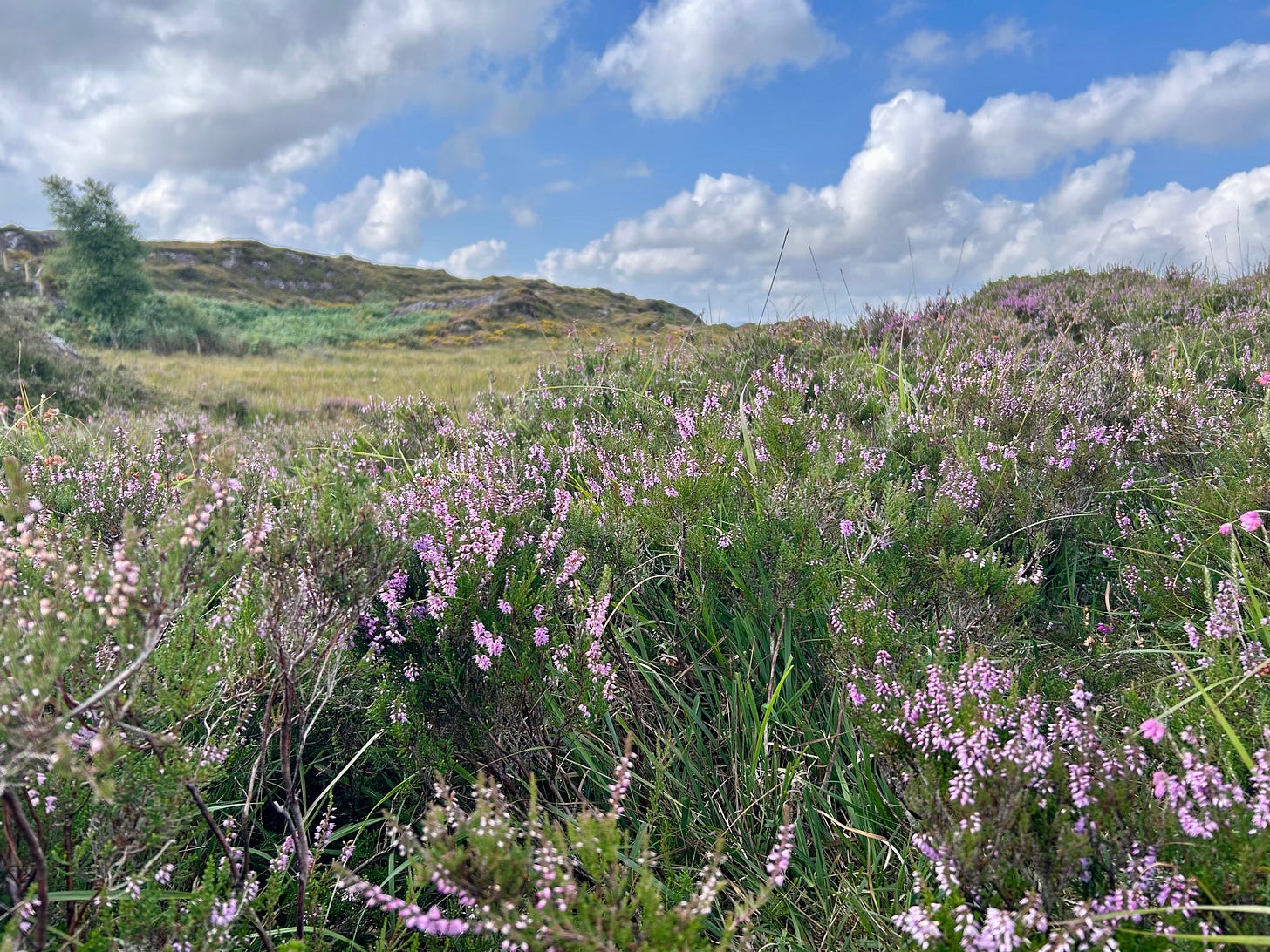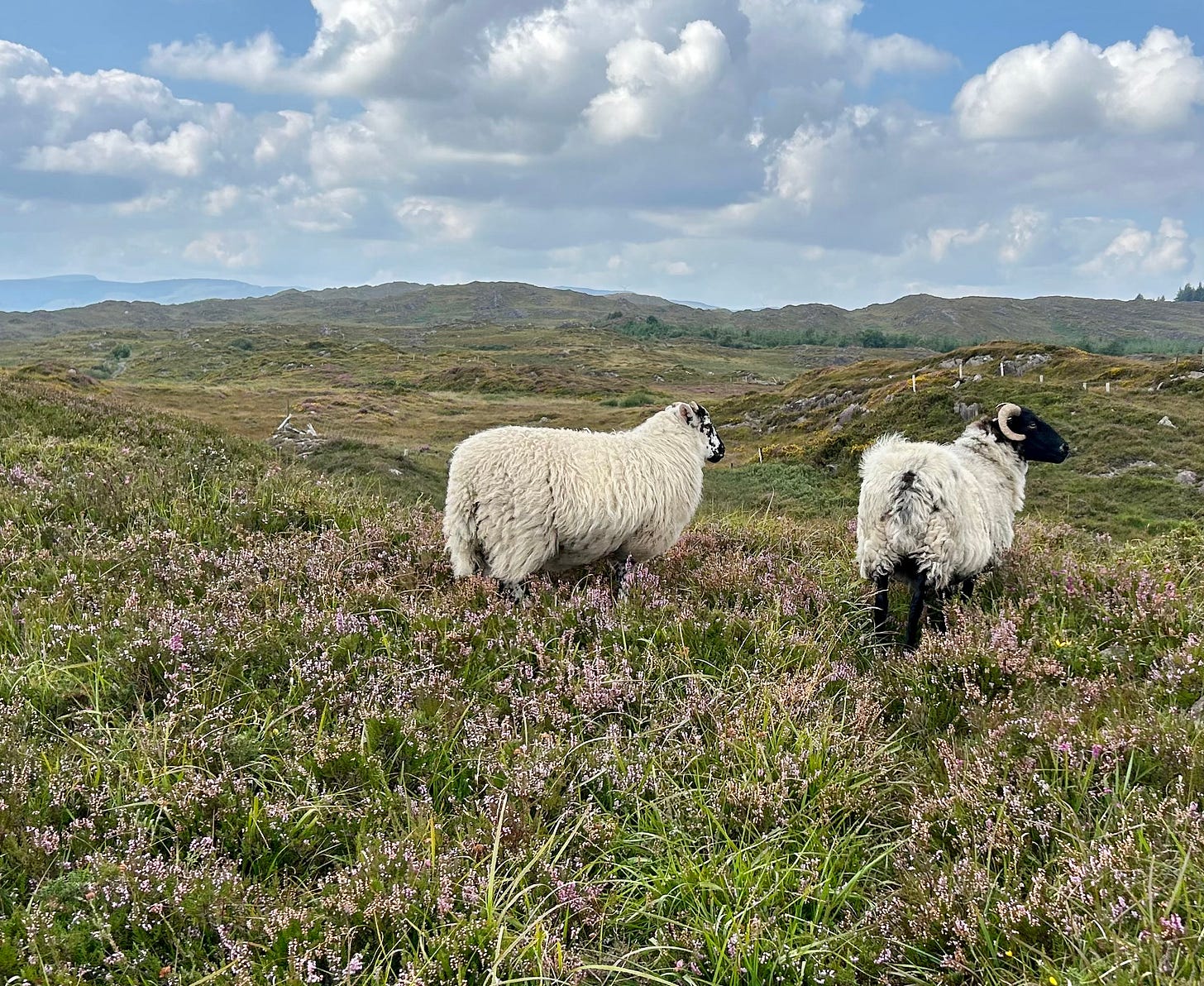Hello and welcome to new subscribers. Thank you for subscribing. If you haven’t already, please take a look at this Welcome post for what to expect from this little corner of Substack.
Summer broke with a crack of thunder and lightning that ripped through a blackened sky. Almost simultaneous. The storm breaking right over these hills. Over us, perched atop our hill in a little tin box. Then the rain came. Thunderous rain pounding parched soil into mud. Thirsty soil lapping it up like a drunkard guzzling ale. The streams are flowing again. A last flush of green before the season turns.
The season is slowing. Mellowing. The voluptuous greens of summer’s climax maturing into dusky reds and golds. It happens quickly when the weather breaks and the light starts to drop towards autumn, as purple moor grass arches into purple-tipped panicles, rushes bloom in drab brown, deer grass turns gold and heather and western gorse paint the ridges and heaths with royal purple, pink and yellow, colours reflected in the morning’s golden mist that rolls up from the valley and the hazy, pink sunset as it rolls back in from the western hills. The urgent, stifling intensity of high summer has burst into stunning sunrises and a carpet of nectar, the riches of this wild, open landscape.
I’m sitting in the heather in the chill of the early evening waiting for the goats to come in for milking, watching and listening to the bees. So many bumblebees of all different kinds. Too many to count. There are little yellow striped ones, medium sized fuzzy orange ones, and big black heavy ones with white bums. The air hums with them, buzzing from flower to flower and zooming this way and that. A honeybee too. Probably visiting from a nearby hive—there are a few beekeepers producing beautiful heather honey around here. As I write this, my husband is under observation at the doctor’s, having just had a severe reaction to being stung by a bee (one too many times) at his work where there are hives in the garden. He’s okay—he had antihistamine tablets on hand which at double the stated dose slowed his reaction down enough for him to get to a doctor and he’ll now have to carry an epipen—I guess that’ll put a stop to his budding interest in beekeeping.
A kestrel hovers over the heath.
The ducks are shouting from the farmyard, impatient for their grain.
The kestrel dives. The bees hum.
The goats are coming in to be milked and settle in for the night earlier after their day’s forays on the land, their sleek, thickening coats gleaming in the evening light and bellies fat with forage, udders full with heather, gorse, bog myrtle, bramble, willow, birch, purple moor grass, rushes, marsh thistle, pea vetch, knapweed, meadowsweet, mosses and ferns alchemised into sacred sustenance. They come and go as and where they please, taking themselves down to the low fields of bog myrtle, moor grass, royal fern and willow, back in for an hour or two siesta and ruminations on the morning’s forage, and then up to the top pasture for the flowering rushes that are ready to be eaten now, finding their own nutriment and balance with the land (my only stipulation is to keep them off the young trees and the mature hollies whose delectably soft bark is prime game for a goat). The milkers know their routine now: sugar beet treats on the milk stand in exchange for gleanings of the day’s milk. Nobody’s kids are taken off them—a good milk goat, well fed and rearing one or two, will make enough to share. Our buck kids, when the time comes, are butchered straight off their mothers—no weaning stress or running separate herds. We’ve always done it like that with our goats. We don’t have the space to grow them on separately and besides, forced weaning just doesn’t sit well with me.
Nights are stretching into flickering firelight and good books washed down with warm goat milk and heather honey. We’re making plans for winter. Calculating feed and bedding needs. Making decisions on reductions to keep the sheep flock and goat herd in balance with the looming seasonal ebb in the land’s (and our) capacity to hold them. Harvest. As a general rule, for every animal born, one must go, to keep numbers stable. We are still slowly reducing the sheep flock, so for every one born, more than one must go. Our freezers will be filled with mutton again, this winter. Our mountain mutton is good. We’ll be well fed and nourished on heather, gorse and rain. Hard decisions transmute into deep nourishment, the the fat of the land we live on, a celebration of a life lived well.
The first of our ram lambs are already in the freezer—no weaning stress or separation for them, either. They made a good size, not much smaller than they would have made if we weaned and grew them on for another six weeks, but we don’t care about making target weights and this way saves us a lot of hassle and them a lot of stress. Why put them through that for a few more weeks of life, a few more pounds gained? The quality of a life is not measured in weeks. One flock. Less management. Less stress. Less pressure on our land and resources. They got as long as we could get away with until they were causing raucous, almost as big as and trying to hump their mothers. Our ewe lambs and female kids stay with their mothers, aunts and sisters, wean themselves when they’re ready and form strong, matriarchal family bonds that we don’t break. I’m convinced that separation stress is a major cause of ill health in dairy herds especially, and I don’t want stress hormones tainting my milk or meat.
Over the past year or so we’ve been making some changes to how we run the sheep flock, goat herd, and land. Not so much changes as just relaxing a bit. Seeing how, now that they are well into their third year of living on this land all year round (previously having only come here for summer grazing), the animals have settled into their landscape, “hefted" to their hill, and the land has greened to meet them. We haven’t put out hay this summer for the first year yet, or feed to the sheep besides a little bit of sugar beet to see them through the drought in June (our goat and sheep numbers are more than when we ran them here only in summer). Less management, less work. Quite honestly my attempts at any kind of management on this land have been few and short-lived. The goats go where and do as they please. The sheep are given long seasons on large areas of ground, followed by even longer regrowth periods. The result of that has been more grass, greener grass, a longer growing season and healthier animals as the land responds to the pressures of the animals, and the animals unencumbered by my few and feeble attempts at control and now with generational familiarity with the land they live on, find what they need when they need it.
It’s taken five years (into their third living here year round) to get to a point where we can let go and step back a little—for the land to provide and the sheep flock and goat herd, and us, to adapt and settle into the landscape, but we’re now at a point of not having to provide minerals or additional feed to the sheep (only hay and seaweed to the goats when it’s raining because they’re soft dairy goats and this is a harsh, wet and exposed landscape) throughout the growing season. Land and flock become one.
It’s nearing two years since I started this substack and as my posts are beginning to stack up I have begun to archive older posts behind the paywall. All posts will now automatically be paywalled once they reach twelve months old (anyone who’s been with me that long and hasn’t deleted them will still be able to access older posts in your emails, but they’re paywalled on the App and website). So before it disappears behind the paywall in a few days, this is a piece I wrote last year as we began harvest and the seasonal cull that feels fitting to share again today.
The Raven's Call
These words are the spiralling thoughts that formed under a sleepless full moon as we enter harvest season and the closing of the shepherding year. I have left them raw, unabridged.
And lastly, last month my essay for the Nature Chronicles Prize was longlisted! It’s a pretty big competition and I’m honoured to be up in the running with some incredible talent—many of the other twenty-one longlisted entrants are established writers with best-selling titles or columns in major newspapers and even their own Wikipedia pages. I’m one of just a couple of nobodies. The panel of judges is made up of professionals with impressive literary and environmental credentials. It’s hugely encouraging and validating to have my writing and the message behind it, which echoes everything I write about here on our human connection to the land, read and appreciated by them. I don’t expect to get any further in the competition (by the time this reaches your inbox the shortlist will have been announced so assume I’m not on it), but I am excited to share my essay here as soon as the non-publish clause is up (next March). I think you’ll enjoy it.
Thank you, as always, for being here, reading and giving my words your time and space.
Carly







Congratulations on your piece making the “short list”!!! You are an inspiration!
I loved reading this! Once we lived on a little bit of land for a year, with two sweet milking goats and a little flock of chickens. If I ever tried my hand again at farming, I would love to do it exactly like you. There's so much wisdom here.